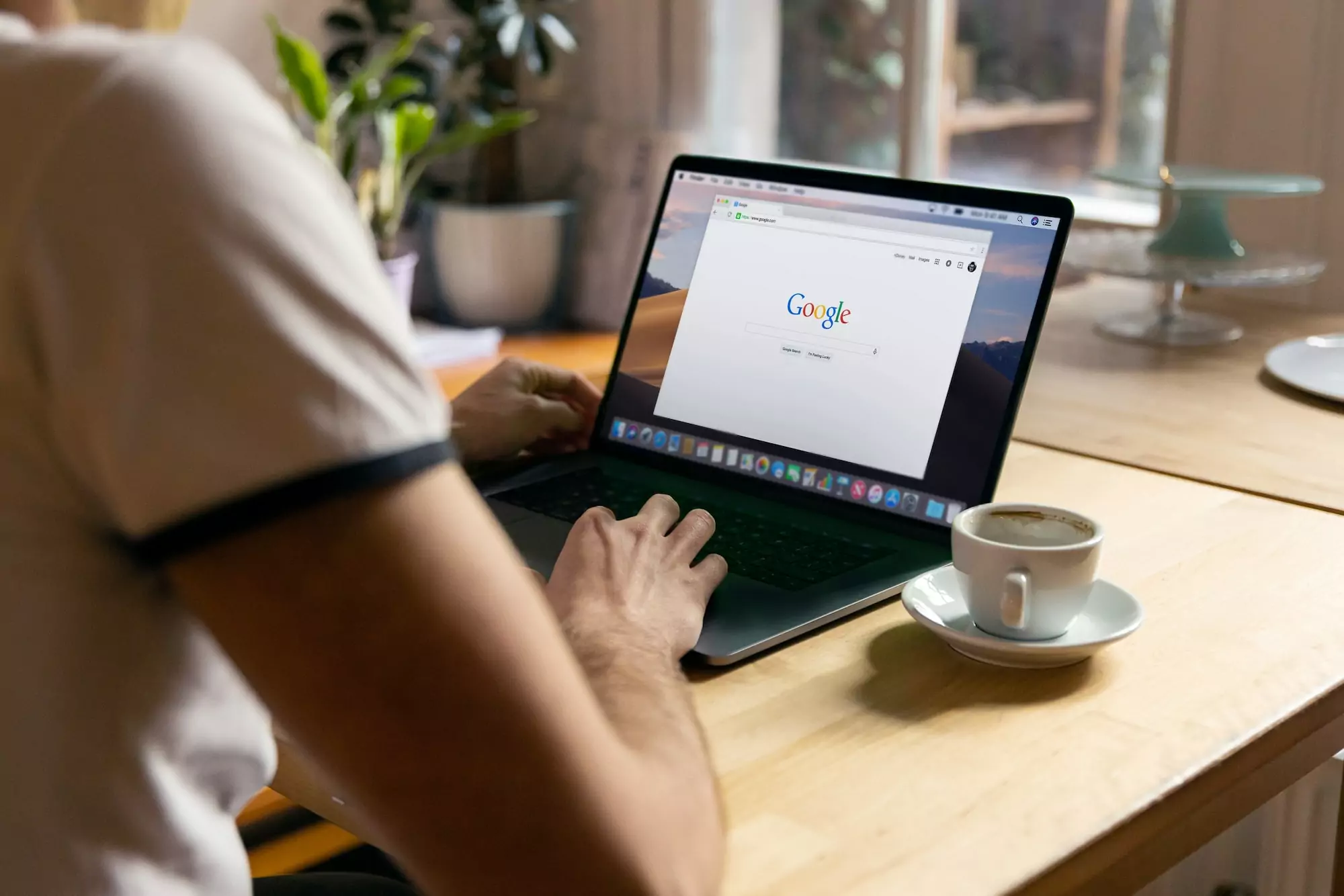As anEcommerce business, and with all the changes in the marketing ecosystem over the past year, you’ve certainly had to rethink your priorities in terms of advertising ROI.
And while many measures have an impact on ROI, let’s first take a look at cost-per-click (CPC), which has an impact on your Google Ads spend and campaigns.
How to reduce the cost per click (CPC) of Google Search ads
Google Search is the starting point for all digital advertisers in developing their online presence. Yet the cost of running Google Search ads is still disconcerting to many.
What is the average CPC for Google Search ads in 2021?
Over the past four years, the average CPC for Google Search ads has varied between $2.39 and $2.69 in the US. This average is slightly higher for the legal and government sectors. Wordstream data shows an average CPC of $2.39, but if you exclude the legal sector from the list, the average CPC is $1.72.
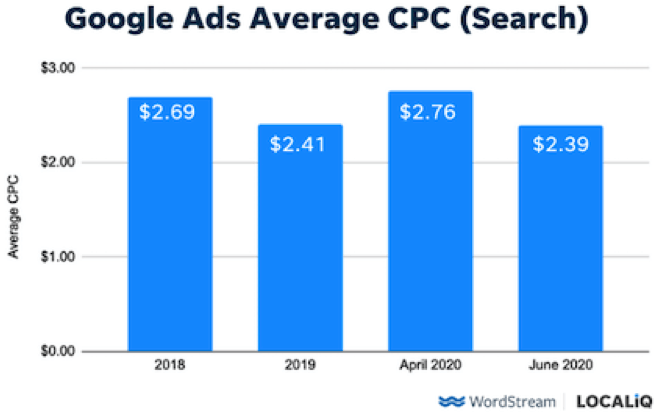
Google search ad CPC history:
– 2018: $2.69 (between $1.16 and $6.75)
– 2019: $2.41 (between $1.30 and $6.35)
– April 2020: $2.76 (between $0.82 and $10.96)
– June 2020: $2.39 (between $0.21 and $15.82)
Although search ads have been around the longest in the world of digital advertising, people still feel like they’re struggling to lower their CPCs. So here are three tips for saving money:
1. Choose your keywords wisely, and don’t settle for the cheapest one!
Keyword research is a given when it comes to Google search, but it’s not just a matter of discarding the most expensive keywords on average. Our advice: don’t ignore a keyword because of its price, but choose it according to the volume and types of search queries you want to attract.
For example, if your most profitable keyword is also your most expensive, you can’t afford not to bid on it. But you can reduce your keyword list to save on other expenses while you’re bidding on this high-converting keyword.
Or, a more expensive keyword may have a higher average search volume, which can translate into more clicks on your website – increasing your expected CTR. This improves your quality score, enabling you to get more clicks for less money in the long term.
In short, you can always choose your keywords based on cost. But make sure you also consider the volume and intent behind those keywords. A good mix of low-cost and high-paying keywords will enable you to get the lowest CPC possible without sacrificing the quality or quantity of conversions.
2. Improve your ads and landing pages to increase your quality score
Remember that bidding is only half the battle when it comes to paying for a click in an auction. For example, an advertiser with a low bid but a high quality score may still win the auction and be more likely to get a click at a lower cost (this is a case where quality score is important).
Google is willing to make this compromise, because it wants to make as much money as possible from paid search ads without sacrificing the user experience. So Google will accept an offer that results in a cheaper click if it means the ad will be more useful to the surfer (in other words, a higher quality score).
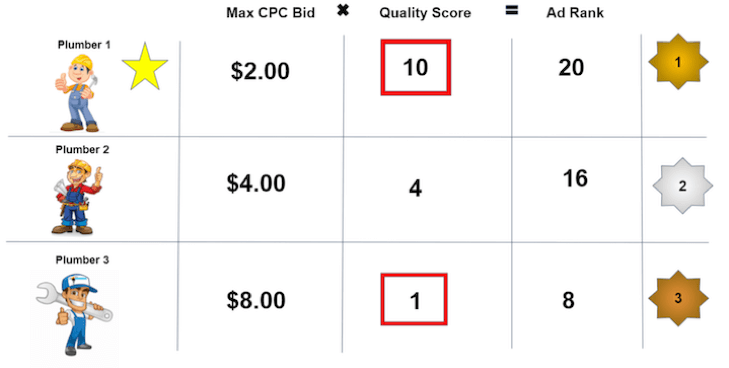
In addition to the expected click-through rate, your keyword quality score also takes into account the relevance of the ad and the landing page experience. So try to devote time to regularly updating your ads and including new, relevant keywords.
You can also take a look at Google’s suggestions from the platform’s ad editing section to see where your current ad strength lies and what you can improve.
When it comes to your landing pages, make sure your main keywords appear on the page, just as you would with your ad text.
3. Try the Research Partner Network
Google’s Search Partner Network allows your ads to be displayed on any other search-enabled site in the Google family.
Historically, clicks from search partners were cheaper, because they were less competitive. You can choose to include your campaign here, and measure results against the Google SERP whenever you like – an excellent way of testing the cheapest clicks.

How can I reduce the cost per click (CPC) of Google Display ads?
Google Display ads behave differently from Google Search ads, which makes estimating costs a little more confusing. To help you out, here’s the latest Google Display data:
What is the average CPC for Google Display ads in 2021?
Over the past four years, the average CPC for Google Display ads has fallen. According to Wordstream, it has dropped from $0.66 to $0.41. And if you take out the Occasions and Gifts sectors, the cost-per-click (CPC) is even lower, dropping to $0.34.
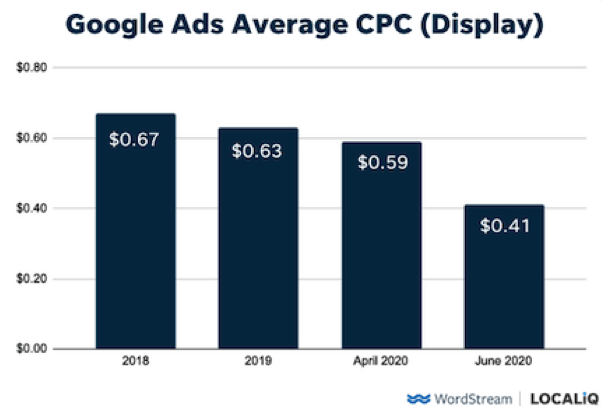
Historical display CPCs:
– 2017: $0.67
– 2018: $0.63 (ranging from $1.16 to $6.75)
– 2019: $0.59 (ranging from $0.60 to $0.81)
– April 2020: $0.41 (ranging from $0.28 to $1.01)
Reducing CPCs for Google Display ads is not a common goal, as they’re often just a few cents per click. Even so, you need to look at your advertising efforts holistically to see where you can save money to offset areas that are worth investing more in.
Here are a few ideas for further reducing your display CPCs, so that you can devote these expenses to potentially more expensive and higher-value keywords in search.
4. Exploit exclusions
Since Display ads can be displayed by default across the Display Network, it’s important to use exclusions to avoid spending on more expensive, irrelevant clicks.
There are the normal exclusions available for all campaign types that you can also apply to Display, such as locations.
In addition to the basic essentials, such as locations, here are some Display-specific exclusions you’ll also want to check:
– Subjects: Are there any types of pages with content related to subjects that wouldn’t be suitable for your Display ad?
– Audiences: Are there additional audiences you don’t want to target? For example, your customers or remarketing audiences.
– Placements : Do you want to display your advertising on all types of websites or applications?
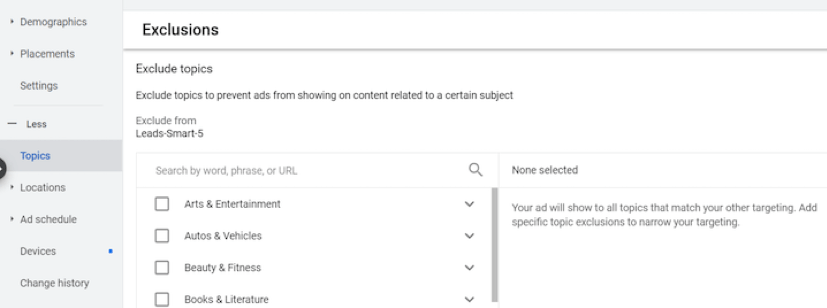
You can easily update and manage display exclusions with Google’s dynamic exclusion lists.
5. Reassess your bids
The amount you’re willing to pay per click correlates with the amount the platform is willing to accept. If competition and other factors help you determine the bid amount for your Display ad groups (manual bidding is only defined at ad group level on Display), you can also try reducing your maximum CPC bid to attract only the clicks that match your budget.
However, if you’re using an automated bidding strategy, you can’t always make this specific call (unless you adjust the strategy’s objective, maximum or target).
Your best bet is to A/B test the bidding strategies that seem most effective.
6. Test your audience targeting with A/B testing
As well as testing different ways of bidding to get the lowest possible bid, you can also apply several audiences to your Display campaign and compare which ones get the lowest CPCs. The approach is similar to that used to select keywords for a search campaign.
The most profitable audience doesn’t necessarily have the lowest CPC. However, it’s best to try out several audiences to see which one makes you the most money, or to have a healthy balance between a high-paying audience and a low-cost one.
How can I reduce the cost per click (CPC) of Google Shopping ads?
Google Shopping campaigns can be tricky to get to grips with, because their infrastructure is different from the one you’re used to for search or display.
What is the average CPC for Google Shopping ads in 2021?
According to Wordstream’s most recent data, the average CPC for Google Shopping ads is $0.58, with a range from $0.17 to $1.55.
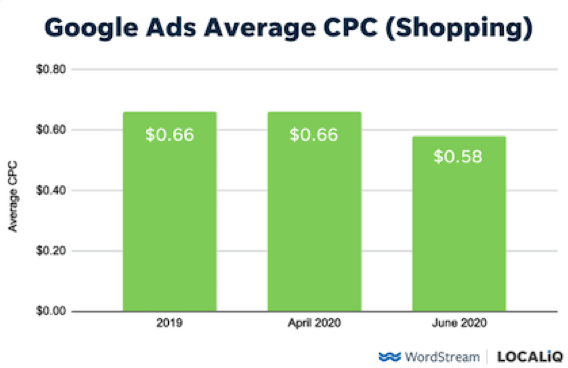
Google Shopping CPC history:
– 2019: $0.66 (ranging from $0.34 to $1.09)
– April 2020: $0.66 (ranging from $0.29 to $1.07)
– June 2020: $0.58 (ranging from $0.17 to $1.55)
Reducing the CPC of Google Shopping campaigns takes time and patience! Here are a few ways you can get a head start now to achieve lower CPC results over the long term:
7. Create negative keyword lists including a few competitors
Since you can’t choose your keywords in Google Shopping campaigns, a healthy negative keyword list is at the heart of any successful Shopping campaign.
But how can you optimize this list for CPC?
We know that stronger competition on the SERPs can drive up CPC prices. It may therefore be a good idea to eliminate the names of big-brand competitors that you feel don’t match your company’s products on the SERPs, especially if you’re a brand that’s not yet well known.
This way, you’re on an equal footing and not paying for more expensive clicks because you’re appearing next to big brand products.
8. Try the “priority” structure for auctions
It’s advisable to prioritize the structure of your Shopping campaign according to the type of traffic your products are targeting. This way, you’ll be able to distribute your bids to save on your overall CPC.
For example, competition for generic searches is higher, and this audience is more likely to be at the top of your conversion funnel.
If you don’t want to waste your high bids on searches that have a low probability of conversion, but still try to capture this audience, there’s a solution: the priority bid campaign structure.
It takes risks on CPC, but helps your campaigns evolve.
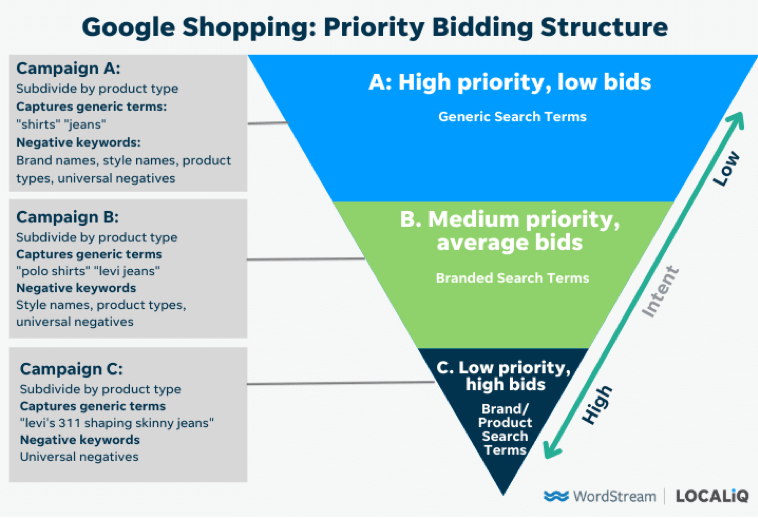
9. Optimize your product flow attributes
Google associates your products with searches based on your product feed. If your attributes are inadequate, you’re more likely to waste your CPC on irrelevant clicks.
If you feel that your CPC is high, take a step back and examine your product flow. Are all attributes correct for each product?
Can you modify the attributes of your products to better match the intent of your ideal researcher?
By answering these questions and manually optimizing your Google Shopping product feed, you’ll help Google match your product ads to the best possible searches to maximize the value of every click you get.
How can I reduce the cost per click (CPC) of Facebook ads?

Facebook ads are totally different from Google ads, as they can’t be displayed within a search box. So you need to optimize them not only for display when someone is browsing Facebook apps (including Facebook, Messenger and Whatsapp), but also to get the cheapest click possible.
What is the average CPC for Facebook ads in 2021?
For all campaign objectives combined, the average CPC for Facebook ads is $0.97, with a range from $0.25 (catalog sales) to $3.30 (brand awareness).
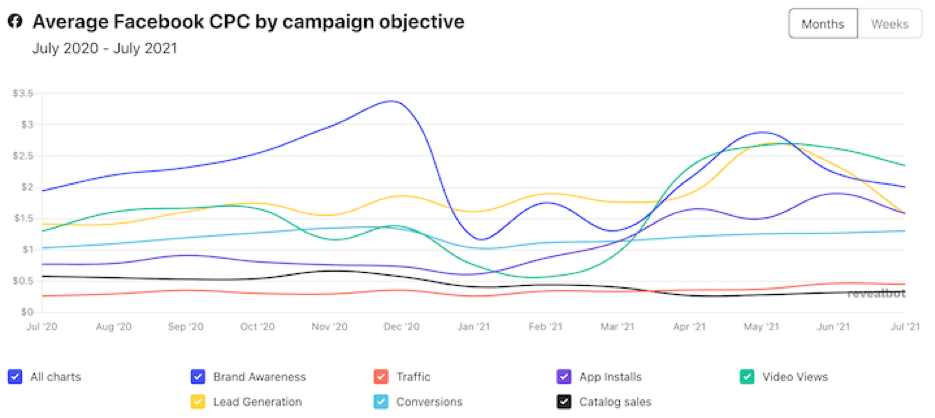
Although it’s not as simple as choosing the cheapest keyword, Facebook’s advertising platform allows you to make interesting changes to reduce CPC:
10. Perform A/B tests on your advertising copy
One of the easiest ways to optimize clicks on Facebook is to try changing the text of your Facebook ad.
You’d be surprised how two different ads within the same ad set can generate completely different average CPCs.
This is because Facebook’s machine learning classifies your ad before deciding when, where and how often to show it.
If Facebook determines that the text and images in your ad won’t drive any actions, you’ll pay more for the click of that ad.
To perform an A/B test on your Facebook ads, try swapping images, CTA buttons or text to improve the CPC of your Facebook ad.
11. Choose your campaign objective wisely
Choosing the wrong objective can be a costly mistake when it comes to Facebook advertising.
Indeed, the objective of your Facebook campaign determines how your ad will be delivered. As with Google’s automated bidding strategies, certain objectives can result in a higher CPC, as they prioritize other actions.
For example, a campaign objective optimized for conversions may appear at times when the CPC is higher because you’re more likely to convert.
It’s best to try out a campaign objective that best matches your final objective, and if you’re not sure, split your campaigns to test two objectives simultaneously!
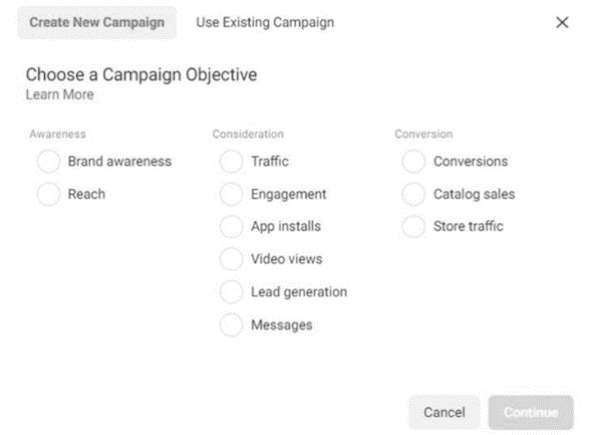
12. Try ad programming
Ad scheduling is a cost-saving feature that you can apply to the ad sets in your Facebook campaigns.
Although this feature is only available if you’ve set a lifetime budget, you can use ad scheduling as a way of controlling your overall Facebook costs and even your CPC, as you decide when your ads are shown.
So, if you notice that you’ve attracted irrelevant clicks that drive up your CPC, but don’t convert, you can think about when your audience will most appreciate your ad.
If you’re a bar owner and your Facebook ads run at breakfast time or outside opening hours, you run the risk of increasing your CPC on wasted clicks!
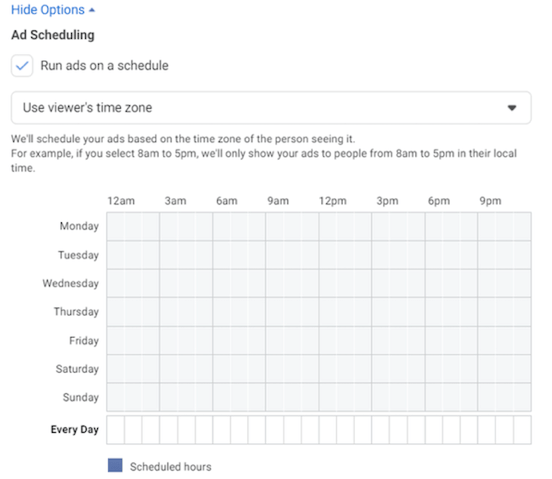
How to reduce the cost per click (CPC) of Instagram ads?

Under the umbrella of the Facebook platform, Instagram ads live within another social media that can be tricky to untangle when it comes to your CPC.
What is the average CPC for Instagram ads in 2021?
Instagram’s average CPC is $1.23 for all campaign objectives, with a range of $0.20 (traffic)-$7.00 (lead generation).
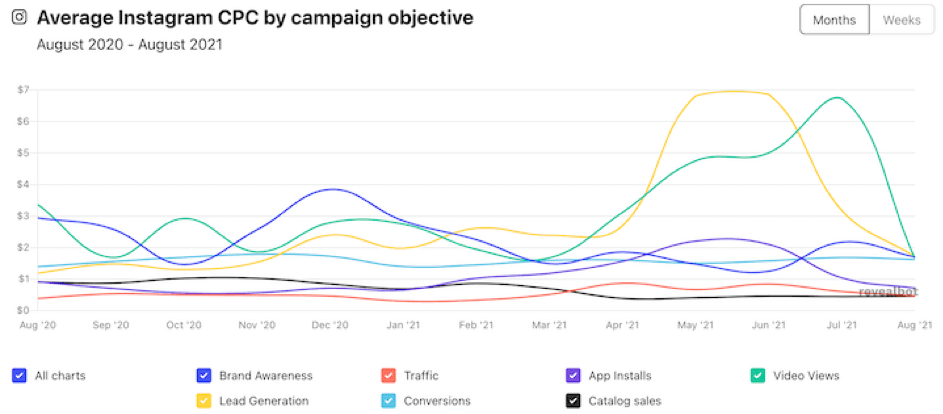
The current CPC of your Instagram ad is not an end in itself, don’t forget! But you can still work towards a lower CPC with the following optimizations:
13. Customize placements
If you’re running ads only on Instagram from Facebook’s platform, then you already know that you can customize your placements.
However, even within Instagram placements, there are multiple ways to display: on stories, news feeds, and more.
Make sure you select the Instagram placements that best suit your type of advertising.
14. Be selective in your targeting
With such a saturated platform, it’s vital to be selective about who your ad is shown to. To save yourself a high CPC on Instagram, don’t cast a wide net.
With so many audience options to choose from, don’t be afraid to be selective by age, location and interests when configuring your ad set.
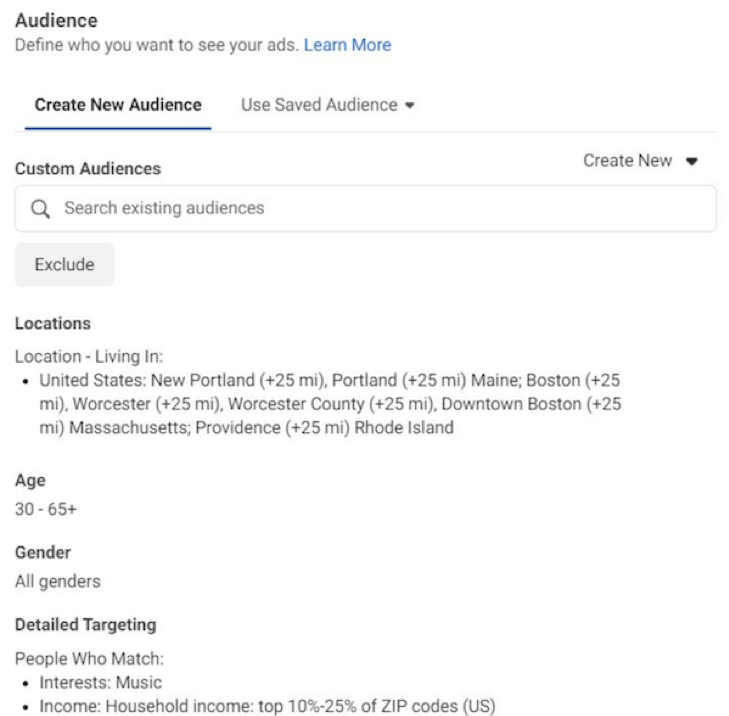
15. Focus on engagement
Once you’ve set up your ad set for specific targeting and placement, focus on the ad content that will drive engagement.
When your ads generate actions such as comments, likes and shares, Instagram’s algorithm will rank you higher.
Your ads will also be more likely to generate conversions and growth, as they will capture your audience’s attention.
For starters, try an Instagram video ad to engage your audience in the comments.
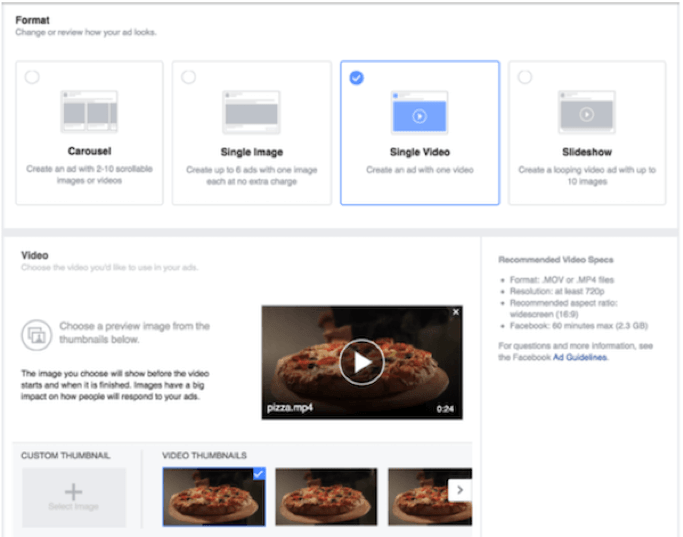
In conclusion
To reduce your CPC in Google search ads:
– Choose your keywords wisely (and not just on the basis of cost)
– Improve your ads and landing pages to obtain the best Quality Score
– Try out the network of search partners
To reduce your CPC in Google Display ads:
– Take advantage of exclusions
– Reassess your bids
– A/B test your audience targeting
To reduce your CPC in Google Shopping ads:
– Create negative keyword lists that include competitors
– Try the “priority” bidding structure.
– Optimize product feed attributes
To reduce your CPC in Facebook ads:
– Run A/B tests on your ad text.
– Choose your campaign objectives wisely
– Try ad scheduling
To reduce the CPC of Instagram ads:
– Customize placements
– Be selective in targeting
– Focus on engagement
Would you like us to help youoptimize your Google, Facebook or Instagramcampaigns? Contact us, our teams of online advertising experts will be delighted to help you with a specific topic or provide you with long-term support.
